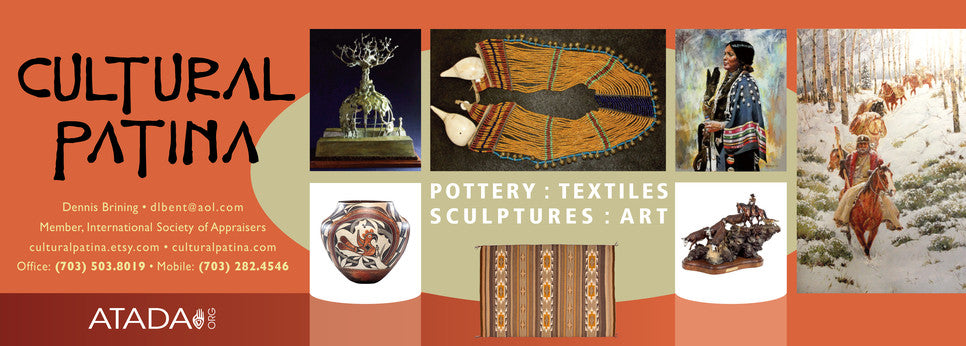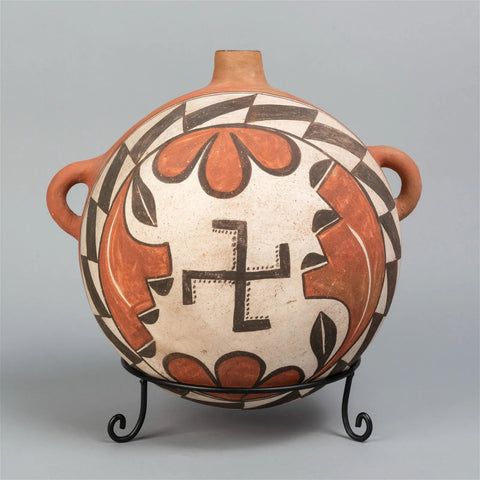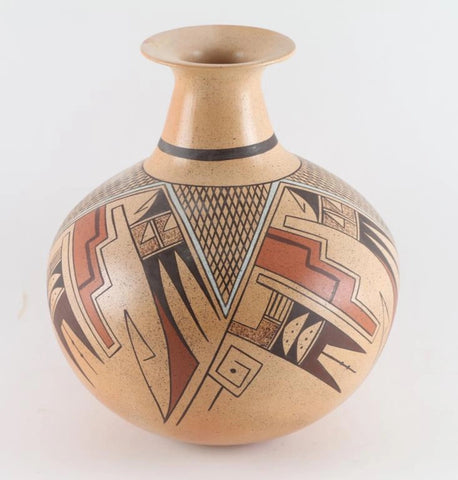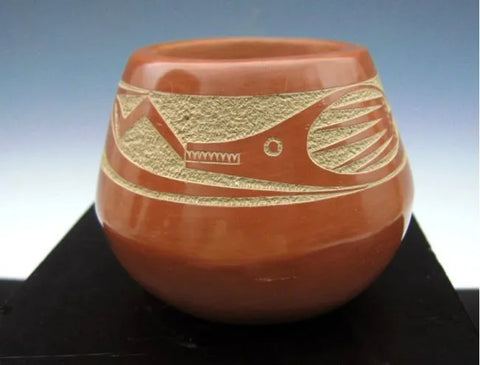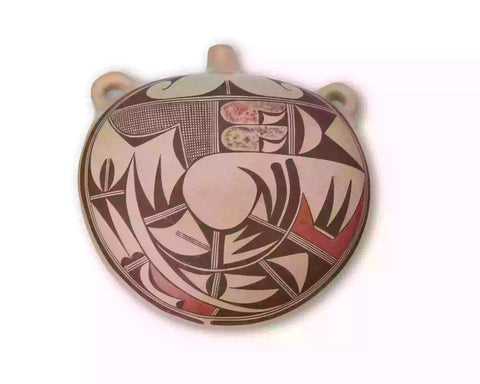Native American, Mohave Pottery Doll by Betty Barrackman "Norge", Ca 1970's #1026
$ 1,600.00
1026 Description: Native American Mohave Doll by Betty Barrrackman “Norge” 1960’s-1970’s
Dimensions: 8.5 inches tall
Condition: Excellent for age
Betty Barrackman often signed her pottery with her clan name Norge. She lived in Needles and was a self-taught potter who was productive in the 1960's and 1970's decades. She made a variety of vessel and human and animal shapes
Mojave Dolls by Deborah Ward, Curatorial Assistant c. 1910-1920 Catalog No. Z141 Donor/Collector: Anthony G. Zallio
In the first half of the 20th century, the Mojave Indians made many dolls for Euro-American tourists passing through Needles, California on the train. The dolls are made of un-fired clay, and as a result are very fragile. These female figurines are dressed in cloth skirts and wear necklaces of beads, horse-hair covers their head, and their bodies are painted with red, yellow and black pigment in traditional Mojave Indian patterns. While we do not know when it was that the Mojave first began creating clay human figures, the earliest documented example was collected on the Whipple expedition (1854). After 1883, when the railroad route was established through Needles, the Mojave Indians were making the clay dolls for sale to Euro-American tourists.
The depot at Needles, "El Garces," had a lunch counter, cafeteria, and marketplace.The Mojaves sold souvenir ceramics on the platform and in the store. The dolls, made in both female and male figures, are not likely caricatures of specific individuals. Instead, the makers of the dolls emphasized culturally significant body parts. Generally, the dolls have enlarged heads and eyes, with simple bodies, arms and legs. Large eyes were considered beautiful by the Mojave people, and the women often outlined their eyes to make them look bigger and to emphasize their eyelashes. Both male and female dolls have large, outlined eyes, often with large pupils. The faces and bodies of the dolls were painted with pigment in designs appropriate for each gender. For the Mojave Indians, face and body paint was a sign of wealth, and a rich Mojave could afford to paint elaborate lines and renew them often. Although the Mojaves did not consider large feet beautiful, occasionally the feet of the dolls were made large to support a standing form.
Other forms of pottery made by the Mojave Indians for sale to tourists included traditional ollas (water jars) and spoons, pitchers, cups, vessels with handles, and effigies of frogs, fish and birds. Early tourists who bought Mojave pottery did not record the names of the artists, so we know none of the early potters. By the mid-20th century, trains and tourists had died out, but the tradition of pottery making passed from some of the elders to younger family members. Two 20th century Mojave Indian potters, Annie Fields (1884-1971) and Elmer Gates (1929-1990) carried on the tradition of Mojave pottery and dolls. The Dillingham Collection of Mojave pottery at the Indian Arts Research Center (School of American Research in Santa Fe, New Mexico) contains several examples of pottery and dolls from both Fields and Gates, along with over 200 other fine pieces of Mojave Indian pottery. Further Reading: Furst, Jill Leslie (2001) Mojave Pottery, Mohave People: The Dillingham Collection of Mojave Ceramics. New Mexico: School of American Research Press. Museography: Notes on Material Culture features research undertaken by Anthropology Museum interns and curatorial assistants. (Source Terri Castaneda, Ph.D.)
Dimensions: 8.5 inches tall
Condition: Excellent for age
Betty Barrackman often signed her pottery with her clan name Norge. She lived in Needles and was a self-taught potter who was productive in the 1960's and 1970's decades. She made a variety of vessel and human and animal shapes
Mojave Dolls by Deborah Ward, Curatorial Assistant c. 1910-1920 Catalog No. Z141 Donor/Collector: Anthony G. Zallio
In the first half of the 20th century, the Mojave Indians made many dolls for Euro-American tourists passing through Needles, California on the train. The dolls are made of un-fired clay, and as a result are very fragile. These female figurines are dressed in cloth skirts and wear necklaces of beads, horse-hair covers their head, and their bodies are painted with red, yellow and black pigment in traditional Mojave Indian patterns. While we do not know when it was that the Mojave first began creating clay human figures, the earliest documented example was collected on the Whipple expedition (1854). After 1883, when the railroad route was established through Needles, the Mojave Indians were making the clay dolls for sale to Euro-American tourists.
The depot at Needles, "El Garces," had a lunch counter, cafeteria, and marketplace.The Mojaves sold souvenir ceramics on the platform and in the store. The dolls, made in both female and male figures, are not likely caricatures of specific individuals. Instead, the makers of the dolls emphasized culturally significant body parts. Generally, the dolls have enlarged heads and eyes, with simple bodies, arms and legs. Large eyes were considered beautiful by the Mojave people, and the women often outlined their eyes to make them look bigger and to emphasize their eyelashes. Both male and female dolls have large, outlined eyes, often with large pupils. The faces and bodies of the dolls were painted with pigment in designs appropriate for each gender. For the Mojave Indians, face and body paint was a sign of wealth, and a rich Mojave could afford to paint elaborate lines and renew them often. Although the Mojaves did not consider large feet beautiful, occasionally the feet of the dolls were made large to support a standing form.
Other forms of pottery made by the Mojave Indians for sale to tourists included traditional ollas (water jars) and spoons, pitchers, cups, vessels with handles, and effigies of frogs, fish and birds. Early tourists who bought Mojave pottery did not record the names of the artists, so we know none of the early potters. By the mid-20th century, trains and tourists had died out, but the tradition of pottery making passed from some of the elders to younger family members. Two 20th century Mojave Indian potters, Annie Fields (1884-1971) and Elmer Gates (1929-1990) carried on the tradition of Mojave pottery and dolls. The Dillingham Collection of Mojave pottery at the Indian Arts Research Center (School of American Research in Santa Fe, New Mexico) contains several examples of pottery and dolls from both Fields and Gates, along with over 200 other fine pieces of Mojave Indian pottery. Further Reading: Furst, Jill Leslie (2001) Mojave Pottery, Mohave People: The Dillingham Collection of Mojave Ceramics. New Mexico: School of American Research Press. Museography: Notes on Material Culture features research undertaken by Anthropology Museum interns and curatorial assistants. (Source Terri Castaneda, Ph.D.)
Related Products
Sold out
